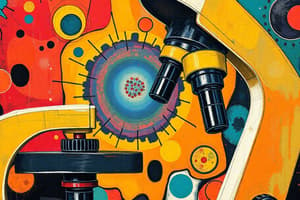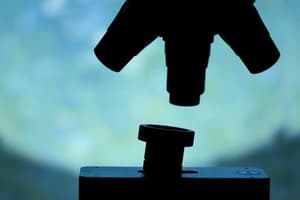Podcast
Questions and Answers
Which type of microscope uses electrons to visualize objects?
Which type of microscope uses electrons to visualize objects?
- C - Scanning Electron Microscopy
- A - Light Microscopy
- B - Transmission Electron Microscopy (correct)
- D - Fluorescence Microscopy
What is the purpose of an extracellular layer in cells?
What is the purpose of an extracellular layer in cells?
- To allow adjacent cells to communicate
- To visualize dead biological specimens
- To strengthen cells and bind them together (correct)
- To distinguish two separate points
What is the definition of resolution in microscopy?
What is the definition of resolution in microscopy?
- The ability to distinguish two separate points
- The ability to look at very small objects
- The measurement of image sharpness (correct)
- The ability to visualize living specimens
Which type of microscope has higher resolution?
Which type of microscope has higher resolution?
What happens to the image when a microscope has low resolution?
What happens to the image when a microscope has low resolution?
What is the main difference between Light Microscopy and Electron Microscopy?
What is the main difference between Light Microscopy and Electron Microscopy?
What is the purpose of cell-cell connections?
What is the purpose of cell-cell connections?
What is the function of the extracellular layer in cells?
What is the function of the extracellular layer in cells?
What is the purpose of resolving power in microscopy?
What is the purpose of resolving power in microscopy?
What is the definition of resolution in microscopy?
What is the definition of resolution in microscopy?
Which of the following is NOT a function of the extracellular matrix (ECM)?
Which of the following is NOT a function of the extracellular matrix (ECM)?
What is the main protein fiber found in the extracellular matrix (ECM)?
What is the main protein fiber found in the extracellular matrix (ECM)?
What is the function of tight junctions between animal cells?
What is the function of tight junctions between animal cells?
Which type of cell junction is common in epithelial and muscle tissue?
Which type of cell junction is common in epithelial and muscle tissue?
In plant cells, how are adjacent cells connected?
In plant cells, how are adjacent cells connected?
Which of the following is NOT a type of cell adhesion protein?
Which of the following is NOT a type of cell adhesion protein?
What is the main function of gap junctions between animal cells?
What is the main function of gap junctions between animal cells?
What is the main function of desmosomes between animal cells?
What is the main function of desmosomes between animal cells?
Which of the following is a correct statement about cell-cell attachments in eukaryotic cells?
Which of the following is a correct statement about cell-cell attachments in eukaryotic cells?
Which of the following is NOT a function of the extracellular matrix (ECM)?
Which of the following is NOT a function of the extracellular matrix (ECM)?
Flashcards are hidden until you start studying
Study Notes
Microscopy
- Electron microscopes use electrons to visualize objects, providing higher resolution than light microscopes.
- Resolution in microscopy refers to the minimum distance between two points that can still be distinguished as separate.
- Electron microscopes have higher resolution than light microscopes due to the shorter wavelength of electrons compared to light.
- Low resolution in a microscope results in a blurry or indistinct image.
- The main difference between Light Microscopy and Electron Microscopy is the type of illumination used: light vs. electrons.
Cell-Cell Connections and Extracellular Matrix
- The extracellular layer in cells serves as a supporting structure, regulates the movement of molecules, and provides mechanical strength.
- The purpose of cell-cell connections is to facilitate communication and adhesion between adjacent cells.
- The main protein fiber found in the extracellular matrix (ECM) is collagen.
- Tight junctions between animal cells function to prevent the leakage of molecules between cells.
- Gap junctions between animal cells allow for the direct exchange of molecules between cells.
- Desmosomes between animal cells function to hold cells together and provide mechanical strength.
- In plant cells, adjacent cells are connected through plasmodesmata.
- Adherens junctions are common in epithelial and muscle tissue.
Functions of Extracellular Matrix
- The extracellular matrix (ECM) provides structural support, regulates cell behavior, and serves as a reservoir for signaling molecules.
- The ECM does not function as a hormone-producing organ.
Note: Some questions had duplicate or similar information, so I've condensed the notes to focus on the key facts and concepts.
Studying That Suits You
Use AI to generate personalized quizzes and flashcards to suit your learning preferences.




